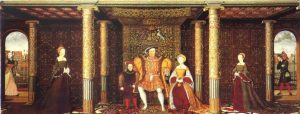
The Gunpowder Plot is often thought of as an event in history in isolation. But in fact it is one (albeit significant) event during a 150 year period of immense religious, societal and parliamentary change which starts with the English church breaking with Rome and ends with the Glorious Revolution of 1688.
The seeds of the Gunpowder Plot were sown many years before during the reigns of Henry VIII and his children, Edward, Mary and Elizabeth.
Henry swept away the authority of the Pope and became Head of the Church in England. For Henry, an absolutist, it suited his world view of there being only one master of a realm. For him, split loyalties (to him as Sovereign and Pope as head of the Catholic Church) did not sit well. It also achieved the other intention of divorcing from his first (and very popular with the public) wife, Catherine of Aragon so that he could marry his second wife, Anne Boleyn.
During Henry’s reign, there was not active persecution of Catholics, but key positions went to Protestants and the wealth of Catholic monasteries was seized.
When Henry died, his will defined the succession: his son Edward followed by his eldest daughter Mary (daughter of Catherine of Aragon and a Catholic), then Elizabeth (Daughter of Anne Boleyn and Protestant) and finally Jane Grey (cousin and Protestant).
Edward became King at the age of 9 when his father died. During his minority, England was governed by a Regency led by his Uncle, Edward Seymour, and later by the Duke of Northumberland, which increasingly reformed the church to evolve from a Catholic church with the monarch as its head, to a more Protestant institution.
In 1553 at the age of 15, Edward fell gravely ill. Worried about the succession passing to his elder Catholic sister Mary and unwinding the Protestant reforms, Edward and his council devised a new succession. As they couldn’t legitimately name his younger sister Elizabeth over Mary, they named his first cousin once removed, Lady Jane Grey, as his heir.
Edward died and Jane Grey became Queen. Mary was furious, raised an army and marched on London. Mary was popular with the public and Jane’s reign lasted for 9 days before the Privy Council switched its allegiance to Mary. Mary was proclaimed Queen, and Jane arrested and eventually executed for high treason.
Mary reversed all of the Protestant reforms and reinstated Catholicism as the state religion. She married Philip of Spain to further strengthen the Catholic Church in England. Had Mary and Philip had Children, there is a good chance that England would have remained Catholic. But they didn’t. Philip returned to Spain, and Mary became increasingly hardline towards Protestants. The Marian Persecutions began, with protestants who refused to convert to Catholicism being imprisoned or worse burnt at the stake for heresy. Kenneth O. Morgan in his book The Oxford Illustrated History of Britain suggests that there were at least 287 executions of people for their faith under Mary’s rule, at least 56 of these being women.
In Lewes, 17 Protestants were burned at the stake between 1555 and 1557. On 6 June 1556, Thomas Harland of Woodmancote, Near Henfield, West Sussex, carpenter, John Oswald (or Oseward) of Woodmancote, Near Henfield, West Sussex husbandman, Thomas Reed of Ardingly, Sussex and Thomas Avington (or Euington) of Ardingly, Sussex, turner were burnt.
Richard Woodman and 9 other people were burned together in Lewes on 22 June 1557, on the orders of Edmund Bonner, Bishop of London — the largest single bonfire of people that ever took place in England.
One of the principal acts of Sussex Bonfire Societies is to commemorate these executions under the Marian regime.
In 1558 Mary died and Elizabeth succeeded her as Queen. She unpicked all of Mary’s reforms as Protestantism is re-established as the state religion. Elizabeth also introduced the Recusancy Laws which compelled people (and their servants) to attend church on Sundays and made it an offence to harbour a Catholic priest.
In 1570, the Pope issued a Papal Bull which excommunicated Elizabeth. The Bull stated that “whomsoever rids the world of this miserable heretic shall be committing no sin”. The Vatican also established the Jesuit order to revive Catholicism in England and stir up rebellion. Catholics were viewed as agents of an enemy power – what we would call Fifth Columnists today.
The English state at this time was under siege from all sides. Most of its neighbours were Catholic and hostile to England. In 1588 – 30 years into Elizabeth’s reign and just 17 before the Gunpowder Plot the Spanish Armada sailed for England with the aim of landing an army to sweep away Elizabeth and her Protestant regime.
It was in this climate of Catholicism being seen as the enemy of the state, that the people that would go on to form the Gunpowder Plot were born.
Elizabeth died in 1603 and was succeeded by James VI of Scotland (Becoming James I of England). One of the principal reasons that James succeeded the childless Elizabeth was that he was a Protestant and would ensure that England continued to be so. Catholics were barred from holding public office unless they swore allegiance to the sovereign (as head of state and of the Church in England).
At the start of James’ reign, he took a softly-softly approach to the plots of disgruntled Catholics, despite most of them having the intention of removing him from the throne. However as the number of plots increased, James reintroduced the recusancy laws, as well as ordering all Catholic priests and Jesuits to leave the realm.
Disgruntled Catholics felt they had to do something…
